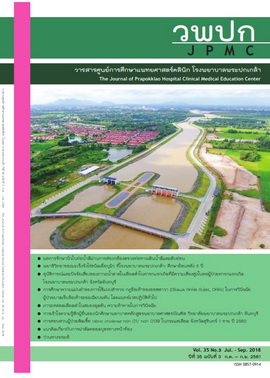Result of treatment common bile duct stone by endoscopic retrograde cholangiopancreatography in Prapokklao hospital
Main Article Content
Abstract
Abstract
Background: Management of common bile duct (CBD) stones by exploring CBD through the removal of the stones by endoscopic retrograde cholangiopancreatography (ERCP) resulting in positive outcomes and few complications.
Objectives: To study the success rate and complication rate of treatment of CBD stones by ERCP.
Materials and methods: Studied and reviewed the records of patients of the hospital who underwent an ERCP operation and had stones removed from October 2011-October 2016.
Results: Five hundred and thirty-four cases of CBD stone removals were included in the study. There was a total of 531 cases (99.44%) of successful cannulation with 454 cases (85.02%) at the first cannulation, 57 cases (10.67%) at the second cannulation, and 20 cases (3.75%) at the third cannulation, respectively. Moreover, there were three cases of unsuccessful cannulation, as one case had a pyloric stricture, another case had gastrectomy and Billroth II anastomosis so the scope could not be passed to the second part of the duodenum, and in the other case, the doctor could not find the ampulla. Five hundred and four cases (94.38%) were removed successfully. In the first instance, 435 cases (81.46%) were removed; in the second time, 60 cases (11.24%) were removed; in the third time, seven cases (1.31%) were removed, and in the fourth time, two cases (0.37%) were removed. Regarding early complications, there were four cases (0.75%) of perforation, one case of duodenal perforation and three cases of ES-related perforation, 27 cases (5%) of mild pancreatitis, nine cases (1.68%) of bleeding, seven mild cases (1.31%), 10 cases (1.87%) of cholangitis, and one case (0.19%) of cholecystitis. However, for late complicatons, there five cases (0.93%) of retained stones, nine cases (1.68%) of recurrent stones, and two cases (0.38%) of cholangitis.
Conclusion: Compared with the American Society for Gastrointestinal Endoscopy (ASGE) guideline, the results of the ERCP to remove CBD stones in Prapokklao Hospital showed a good response as seen by the multiple times of cannulation and stone removal, but most of the cases were done only twice. This resulted in a positive outcome after repeating the ERCP to remove the stones. Moreover, the acute complications were at an acceptable rate from the ASGE guideline except cholangitis.
Keywords: stone; common bile duct stone; complication; endoscopic retrograde cholangiopancreatography
Article Details
References
2. Montian Marytkornkul, Common bile duct stone extraction. Optimizing in surgical endoscopy : Save simple and secure 2014.p.131-141.
3. Tawee Ratanachuake, ERCP Complication:Prevention and management. General Surgery 2013;17:281-305.
4. Cotton PB, Lehman G, Vennes J, et al. Endoscopic sphincterotomy complications and their management: an attempt at consensus. Gastrointest Endosc 1991;37:383-93.
5. Jirawat Sawangsri,Thawatchai Akaraviputh, Update in ERCP Complications. Basic technique in Surgical Endoscopy 2008.p.114-133.
6. Scott T,Incidence, risk factors, and prevention of post ERCP pancreatitis. Gastroenteral clin N Am 2007;36:259-276.
7. Enns R . ERCP related perforations: risk factor and management. Endoscopy 2002;34(4):293-8.
8. Marie lle C.Veldkamp, Iatrogenic ampullary stenosis: endoscopic management, and outcome in a series of 49 patients. Gastrointest Endosc 2007;66:708-16.
9. Gandolfi L, Torresan F, Solmi L, et al: The role of ultrasound in biliary and pancreatic disease. Eur J Ultrasound 2003; 16: pp. 141-159.
10. Mortele KJ, Ji H, and Ros PR: CT and magnetic resonance imaging in pancreatic and biliary tract malignancies. Gastrointest Endosc 2002; 56: pp. S206-S212
11. Mark DH, Flamm CR, and Aronson N: Evidence-based assessment of diagnostic modalities for common bile duct stones. Gastrointest Endosc 2002; 56: pp. S190-S194.
12. Romagnuolo J, Bardou M, Rahme E, et al: Magnetic resonance cholangiopancreatography: A meta-analysis of test performance in suspected biliary disease. Ann Intern Med 2003; 139: pp. 547-557.
13. ASGE. A Journey toward excellence: training future gastroenterologist-The Gastroentrology Core curriculum. third edition. Gastrointest Endosc. 2007; 65(4):875-81.
14. [Guideline] ASGE Standard of Practice Committee. The role of ERCP in benign disease of the biliary tract. Gastrointest Endosc. 2015 ;Apr. 81(4):795-803.
15. ASGE training committee. Endoscopic retrograde cholangiopancreatography: Core curriculum. Gastrointestinal Endoscopy 2016; 83: No.2: 279-289.
16. [Guideline] ASGE Standard of Practice Committee. The role of endoscopy in the management of choledocholithiasis. Gastrointest Endosc. 2011; 74(4):731-744.
17. ASGE. Quality indicator for GI endoscopic procedure. Gastrointestinal Endoscopy Volume 81; No. 1:2015: 54-66.

